Kelmscott School historians research natural history with UCL Special Collections
By Anna R Fineman, on 20 February 2024

Photo of Kelmscott School pupils sitting in the Culture Lab at UCL East. Rare books they are about to explore are displayed on a table in the foreground.
Last term the Outreach team of UCL Special Collections were delighted to collaborate with Year 9 History enthusiasts at Kelmscott School in Waltham Forest. The club, called Becoming an Historian, took place over six weekly after-school sessions at Kelmscott School. The 18 students defined the skills and qualities which make a good historian, learnt how to undertake historical research of primary resources, and each explored an item from UCL Special Collections in-depth. They chose Natural History as their theme and enjoyed investigating historical beekeeping, beautiful marine watercolours and whether plants have feelings. The students learnt to communicate their research in different ways for different audiences. Here they have produced informative and engaging museum labels to create a digital exhibition. You can also read their personal responses to the collection items on X (previously Twitter).
The students concluded their project by coming to visit UCL East and really enjoyed seeing the original Special Collections items they had been researching, in the Culture Lab:
It was great to see the book that I’ve been working on, it was really rewarding
It was interesting to see the source in person. There were a lot of things you do not catch when using an online version.
It felt really cool looking at something created almost 100 years ago!
UCL Special Collections say a huge thank you to the students for undertaking this research and for helping to tell the stories of these extraordinary rare books and archives in our care.
Every Man His Own Doctor (1673) by John Archer
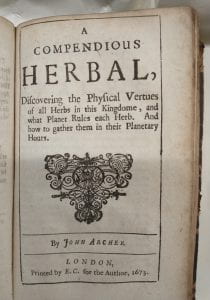
The title page for part two of John Archer’s 1673 herbal Every Man His Own Doctor.
This rare book was written in 1673 by a man named John Archer (1660 – 1684), a King’s chemical physician who believed that every person should know about what they put into their bodies and the effects this might have. The book includes home remedies and cures to treat and prevent pox, gout, dropsy and scurvy. It also includes ways of calming your mind, exercising, sleep and the uses of tobacco.
Lukas
‘Every Man His Own Doctor’ by John Archer is a book that focuses on herbal medicine. It provides information on various plants and their benefits. The book is implying that people should take serious care of their health. It’s great for those who are interested in exploring different treatments and is useful for those who want to learn more about healthcare.
Madeeha
‘Every Man His Own Doctor’ was written by John Archer. He published the book in 1673, written in English. The book is about diet, herbs and medicine in the 1600s. The book provides detailed information on the properties and uses of numerous herbs. It also includes advice on maintaining a healthy life. The book aims for people to take control of their lifestyle and to benefit from natural remedies.
Noor
Original hand painted artwork by Marian Ray for her filmstrip Seeds (1940s – 1980s)

Artwork by Marian Ray c.1940s – 1980s, for her educational film Seeds
Marian Ray was a successful business owner who began work in the 1940s producing filmstrips for schools. She worked at the BBC during World War Two as an animation artist. She would study seed growing as a source of material, and produced film artwork and a booklet covering: the evolution of seeds and how they grow and live; the nutrients they need; different types and shapes of seed; the animals that love to eat the seeds.
Ayub
The archive of Marian Ray contains artwork and a booklet on seeds. It contains in-depth information about seeds, how they work and different types. It is also about the evolution of seeds, how they grown and live. There are numerous diagrams that show different seeds and parts of seeds.
Raqeeb
Remarks on Rural Scenery by John Thomas Smith (1797)
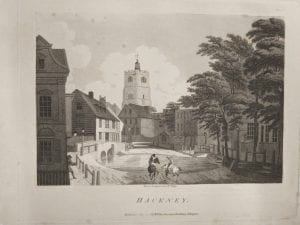
An illustration of Hackney looking extremely peaceful from John Thomas Smith’s 1797 book Remarks on Rural Scenery.
Remarks on Rural Scenery was published by John Thomas Smith, a painter and engraver, in 1797. It shows engravings of rural areas of London in the 18th century; however, these areas are not so rural today. Westminster is depicted as a vast, green area, Hackney a quiet village, Deptford a woodland area with a large cottage. This book is a good way to see what life was like during the 1700s, and to see just how much the world we live in has changed since then. It can help us to discover more about human life and geography through images before the invention of the photograph.
Anton
Marine Sketches from Nature by Edward Duncan (c.1840s – 1880s)

A page from Edward Duncan’s sketchbook Marine Sketches from Nature, featuring a drawing of seagulls swooping in the air and a watercolour landscape of the sea with distant land mass and a golden sky (1840s – 1880s)
In the Victorian era Edward Duncan, a famous British artist, published his sketchbook of marine paintings. The sketchbook, dating from 1840s – 1880s contains watercolour paintings of the sea, boats and landscapes. Duncan was born on 21 October 1803 and died on 11 April 1882 aged 78. He made two sketchbooks – Marine Scraps and Marine Sketches – filled with beautiful watercolour sunsets and oceans. Some of his paintings were called The Shipwreck, The Lifeboat and Oysters.
The sketchbooks are part of Egon Sharpe’s Collection and were donated to UCL Special Collections. Now everyone can benefit from his beautiful sketches.
Amelie
During the Victorian era a series of sketchbooks dating from 1840 – 1880s were made by a British Man called Edward Duncan. He lived from 21 October 1803 to 11 April 1882. These sketchbooks are called Marine Sketches from Nature and Marine Scraps. They contain various sketches and watercolour paintings of marine harbours, animals, landscapes and nature.
Edward Duncan married a woman called Bethia Higgins. The auction of some of his stunning works three years after his passing, took just three days, which showed how sought after his work was.
Kitty
The Feminine Monarchie or The Historie of Bees by Charles Butler (1623)
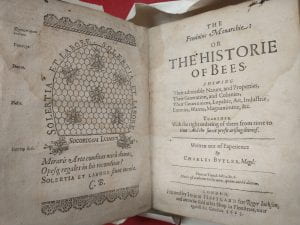
The title page double spread of Charles Butler’s The Feminine Monarchie or The Historie of Bees (1623).
The Feminine Monarchy or the History of Bees is a beekeeping guide that was made by Charles Butler. This guide was used for over 250 years, before people developed moveable comb hives. Charles’ book has ten chapters from swarm catching to the benefits of bees to fruit (pollination). This 1609 science treatise is considered the first book on the science of beekeeping and was translated into Latin in 1678.
Iris
The Feminine Monarchy was made by Charles Butler. He was born in 1571 and passed in 1647. He observed that bees produce wax. He also learned that wax is produced from their own body. He was among the first to assert that the leader was a ‘woman’ aka the queen bee. The Feminine Monarchy was originally published by Joseph Barnes, Oxford in 1609. The book was later translated into Latin.
Diana
The Feminine Monarchy is a guide ‘written out of experience’ by Charles Butler. It is a 1609 science treatise and is considered the first work on the science of beekeeping. Its 10 chapters on bees, which have been used for 250+ years, detail the following: bee gardens; hive-making materials; swarm catching; enemies of bees; feeding bees; and the benefits of bees to fruit (pollination). It has been translated into Latin.
Mariam
Plant Autographs and their Revelations by Jagadish Chandra Bose (1927)

The title pages of Jagadish Chandra Bose’s Plant Autographs and Their Revelations (1927)
This book is about a series of studies on whether plants have feelings and thoughts. One particular tree in Faridpur, Bangladesh, was struck by lighting and now bends at a 60 degree angle. Until it doesn’t… During the morning the ‘neck’ of this tree (Phoenix sylvestris) points upwards. However, during the evening, the tree bows downwards to look like it was praying, which is how this tree earns its name The Praying Palm. ‘Pilgrims were attracted in large numbers. Offerings were made to the tree which had been ‘the means of effecting marvellous cures.’
James
Plant Autographs and Their Revelations is a book about a series of studies that indicate whether plants have feelings or not. There is one tree in the book called the Praying Palm of Faridpur. This tree was a date palm (Phoenix sylvestris). They call it the Praying Palm because in the morning the tree points upwards and in the afternoon it bows downwards. This looked as if it was praying. Pilgrims were attracted in large numbers. Offerings were made for the tree for alleged faith cures. These trees can be found in Bangladesh or Bengal.
Kristian
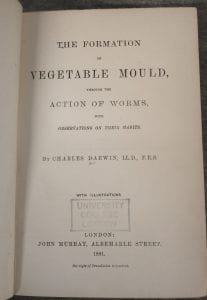
The title page of Charles Darwin’s 1881 book The Formation of Vegetable Mould through the Actions of Worms: with observations on their habits
This is an 1881 book by Charles Darwin on earthworms. It was his last scientific book and was published shortly before he passed away. The first edition went to press on 1st May, and it was remarkably successful , selling 6000 copies within a year, and 13,000 before the end of the century.
Gabriel
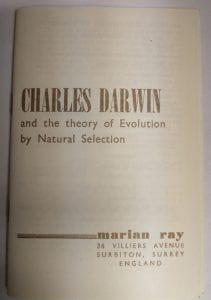
A booklet titled Charles Darwin and the Theory of Evolution by Natural Selection by Marian Ray, to accompany her hand illustrated educational film (c.1940s – 1980s)
We learnt about Marian Ray, a successful businesswoman who was born in 1923 and died in 1999. She created educational film strips for schools, mostly homemade. She translated and sold them to more than 70 countries. She worked in the audio-visual era in World War Two. Her earliest film strips were in black and white and called ‘Cotton’ and ‘Evolution of the Horse.’ One film she made was about Charles Darwin.
Amir
Marian Ray was born in 1923 and died in 1999. She was a successful businesswoman and she made educational film strips for schools. They were homemade and were translated for more than 70 countries. In World War Two she worked in the audio-visual era. Her earliest film strip, black and white, was named ‘Evolution of the Horse.’ She made depictions of Charles Darwin’s observations of horses.
Ismael
 Close
Close


